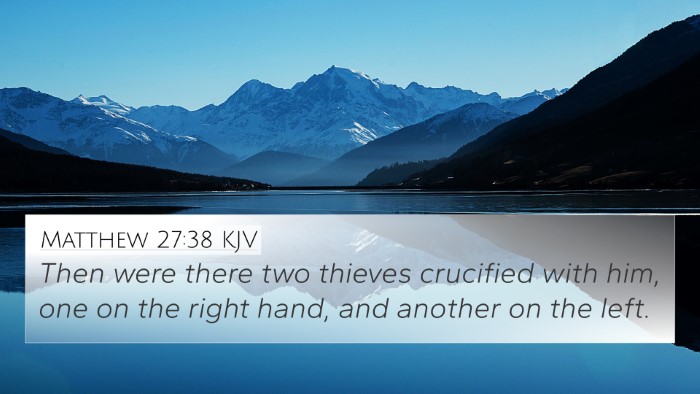Understanding Mark 15:27
Mark 15:27 reads: "And with him they crucify two thieves; the one on his right hand, and the other on his left."
In this verse, we witness the event of the crucifixion of Jesus Christ, accompanied by two thieves. This moment is critical not only within the context of the Gospels but also in the broader scope of biblical theology.
Key Themes and Insights
- Fulfillment of Prophecy: The presence of the criminals alongside Jesus fulfills the prophecy found in Isaiah 53:12, which foretells that the Messiah would be numbered with the transgressors.
- The Nature of Christ's Sacrifice: By being crucified between two thieves, Jesus fully identified with humanity’s condition—He was crucified for our sins, even while associating with the guilty.
- Symbolism of the Cross: The cross becomes a pivotal symbol in Christianity, representing not just Christ’s suffering but also the hope of redemption. The positioning of the criminals illustrates the choices humans face—repentance or rebellion.
Commentary Insights
According to Matthew Henry, the act of crucifying Jesus among thieves enhances the depth of His humiliation. Not only is He treated as a common criminal, but in His suffering, He also articulates the extent of grace extending even to the most sinful.
Albert Barnes emphasizes that the Gospel writers did not shy away from depicting the harsh realities of the crucifixion, instead presenting both the shame and the glory intertwined in the act. Both thieves illustrate the choice of the Gospel: one mocks Christ, while the other acknowledges Him as innocent.
Adam Clarke elaborates on the significance of Jesus’ crucifixion between the two thieves, highlighting that this very location served to show that even in His final moments, Christ was surrounded by suffering, emphasizing the need for divine mercy—available to all, regardless of their past.
Bible Cross-References
Mark 15:27 links with various scriptures, providing a deeper understanding of its themes:
- Isaiah 53:12 – "And he bore the sin of many, and made intercession for the transgressors."
- Luke 23:33 – "And when they were come to the place, which is called Calvary, there they crucified him, and the malefactors, one on the right hand, and the other on the left."
- Matthew 27:38 – "Then were there two thieves crucified with him, one on the right hand, and another on the left."
- John 19:18 – "Where they crucified him, and two others with him, on either side one, and Jesus in the midst."
- Romans 5:8 – "But God commendeth his love toward us, in that, while we were yet sinners, Christ died for us."
- 2 Corinthians 5:21 – "For he hath made him to be sin for us, who knew no sin; that we might be made the righteousness of God in him."
- Luke 23:39-43 – The conversation between Jesus and the repentant thief provides insights on grace, redemption, and the hope of eternal life.
Conclusion
Mark 15:27 serves as a powerful testament to the themes of sacrifice, redemption, and grace. It highlights the connections between Scripture that illustrate God’s unwavering love for humanity. Through cross-referencing various Bible verses, we can observe thematic consistencies that enrich our understanding and reflect the deep inter-Biblical dialogues that carry forward the narrative of salvation.
Additional Study Tools
For those interested in exploring further, tools for Bible cross-referencing, such as a Bible concordance or cross-reference guide, can enhance one’s understanding of Scripture. Utilizing these resources allows for a comparative Bible verse analysis that strengthens one's insight into the connections between Old and New Testament themes.
How to Utilize This Insight
- When preparing sermons, one can use these cross-referenced Bible verses to support theological points.
- Engage in a cross-reference Bible study by identifying links between different parts of the Scripture, enhancing personal and communal understanding.
- Recognize the patterns of sin and redemption by tracing the narrative of the thieves to the broader context of human nature and God's grace.
Through these reflections and studies, we encourage deeper engagement with Mark 15:27, appreciating its profound implications for faith and practice within the Christian walk.





